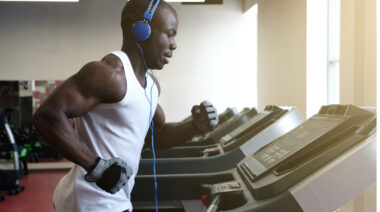Burpees have achieved a lofty status among coaches and athletes. For some coaches they are a form of punishment, for athletes they are often considered a badge of pride, and for hardcore fitness buffs they are a test of intestinal fortitude. A recent study in the Journal of Strength and Conditioning Research examined whether or not they live up to the hype.
Burpees vs. Cycling Intervals
The burpee is a wonderfully simple tool. From standing, you just bend over, put your hands on the floor and kick your feet out. Do a push up, then back onto your feet for a jump. Simple enough, but the bane of your existence if you deign to break a rule or miss a mark.
In the Journal study, researchers compared the burpee to cycling. Out of the three most common cardio exercises (swimming, running, and cycling), cycling seems to be the most demanding for beginners. Getting over a heart rate of 150 bpm is a matter of a quick and fairly easy jog for most, but on a bike it is virtually impossible to maintain that pace for athletes who are not used to it. Additionally, cycling has the benefit of a massive body of research studying its effects. There is no better exercise to compare the burpee to.
Study Design
The participants performed two different protocols in a random order separated by a few days. One involved intervals on the stationary bike. The subjects performed intervals of thirty seconds on and four minutes off for four sets. Light cycling occurred in the four-minute period as active recovery.
The other protocol used the same level of activity and rest, but the subjects did burpees instead of cycling. The active rest for the burpees was a stationary march.
Physiological Response
The VO2 max and heart rates of both the burpee group and the cycling group were similar. Physiologically, the major difference in the test values was in the lactic acid response, which was much higher when cycling. This suggests that the burpees could have been carried on for longer despite having a similar cardiovascular effect.
According to the study, the participants were not experienced in cycling, but had engaged in calisthenics. As an endurance event, cycling tends to take more time to acclimate to than running or swimming for elite performance. As a result, it’s possible that the differences would be greater had the participants been more accustomed to cycling. It’s difficult to say if the same is true of the burpees.
Perceived Exertion
One of the findings, which surprised the researchers, was that the burpees were perceived as easier than the cycling. This might not seem important on the surface, but the ratio of perceived exertion to cardio benefit is perhaps the single most important factor when determining whether or not an athlete will actually work hard at their cardio.
As mentioned above, seasoned cyclists experience different effects from training, and rate of perceived exertion is a big one. For beginners, cycling is known to feel very difficult relative to cardiovascular factors like heart rate. I’d like to see the burpees compared to running, which is probably lowest on the perceived-effort-to-actual-effort charts.
According to this study, burpees provide the intensity you need for fitness improvement. If you have limited time or limited space, or perhaps you just want a change of pace, burpees are a great addition to your routine for improving your cardio.
References:
1. Nicholas Gist, et. al., “Comparison of Responses to Two High-Intensity Intermittent Exercise Protocols,” Journal of Strength and Conditioning Research, DOI: 10.1519/JSC.0000000000000522
Photo courtesy of CrossFit Impulse.






